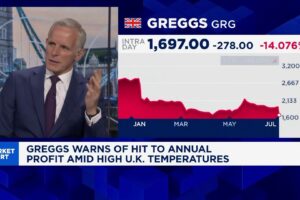
Treasury yields continued to fall on Wednesday, accompanied by a drop in the dollar, as recent soft U.S. economic data continued to underpin bond prices.
Meanwhile, the spread between the rates on the 3-month bill and 10-year Treasury was below zero, inverting that part of the curve and adding to the worrisome signs of an impending U.S. recession.
What’s happening
- The yield on the 2-year Treasury TMUBMUSD02Y, 4.432% slipped to 4.404% from 4.477% on Tuesday. Yields move in the opposite direction to prices.
- The yield on the 10-year Treasury TMUBMUSD10Y, 4.012% retreated to 4.0624% from 4.109% as of Tuesday afternoon.
- The yield on the 30-year Treasury TMUBMUSD30Y, 4.166% was 4.171%, down from 4.264% late Tuesday.
What’s driving markets
On Wednesday, Treasury yields extended their declines from the prior session, when 2- and 10-year rates dipped to their lowest levels in a week, and fell in conjunction with the dollar DXY, -1.05%, which was under pressure against major peers.
Read: U.S. dollar rally takes a breather as currency slumps versus major rivals
Meanwhile, investors are betting that recent soft U.S. economic data will help suppress inflation and reduce the need for the Federal Reserve to continue aggressively hiking interest rates.
With markets increasingly sensitive to housing, Tuesday’s report from the Federal Housing Finance Agency showed home prices fell in August for the second consecutive month, the first time that’s happened since 2011. That seemed to be one of the catalysts for the action in rates, according to researchers at Deutsche Bank.
“We also saw consumer confidence miss, coming in at 102.5, falling from 108.0 in September and by more than expected (105.9), with both present situation and expectations declining. Lastly, a miss on the Richmond Fed manufacturing index (-10 vs -5) added to a downbeat message from the data,” the Deutsche Bank team wrote in a note Wednesday.
Such news, which was followed by Wednesday’s report that the annual rate of new home sales had fallen to 603,000 in September, has hit a market where “liquidity is still thin and…outsized moves can occur due to flows that would have been absorbed much easier prior to the beginning of the tightening cycle,” said Jan Nevruzi, U.S. rates strategist at NatWest Markets.
Markets are pricing in a 93% probability that the Fed will raise interest rates by another 75 basis points to a range of 3.75% to 4% on Nov. 2, and a 56% likelihood of a 50-basis-point hike in December. The central bank is mostly expected to take its fed-funds rate target to at least 4.75% and 5% by March, according to the CME FedWatch tool.
What analysts are saying
“Tuesday’s trend to lower rates survived overnight in the U.S.,” said Jim Vogel, executive vice president at FHN Financial in Memphis.
“Explanations for the rapid, heavy volume move across the curve ranged from greater attention to scattered dovish Fed comments last week, to weaker U.S. data releases, to technicals and to a mass move by commodity traders that sparked a small wildfire,” he wrote in a note. “This morning’s status quo is confirmed by another sizable decline in the dollar.”







